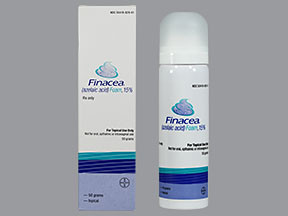AZELAIC ACID FOAM - TOPICAL
PHONETIC PRONUNCIATION: (ay-ze-LAY-ik AS-id)
COMMON BRAND NAME(S): Finacea
GENERIC NAME(S): azelaic acid
Uses
USES: This medication is used to treat a certain skin disorder known as rosacea, a type of adult acne. It helps to decrease redness, swelling, and the number of pimples caused by rosacea.
How to use AZELAIC ACID FOAM - TOPICAL
HOW TO USE: Apply this medication on your face as directed by your doctor, usually twice daily. To avoid irritation, avoid contact with your eyes or inside the nose or mouth. If you accidentally get this medication in your eyes, flush well with cool water. Call your doctor if eye irritation does not go away. Before use, wash the affected area with a mild soap or soap-free cleanser and pat dry. Avoid using other skin care products that may irritate your skin, such as astringents, abrasives, tinctures, cleansers that contain alcohol, and products that cause skin peeling. Shake the container well before each use. Use your fingers to apply a thin layer of medication over your whole face (cheeks, chin, forehead, and nose) and gently massage the foam into your skin. Wash your hands after each use. Makeup may be applied after the medication has dried. Do not use any dressing or covering on the treated area unless directed by your doctor. Use this medication regularly to get the most benefit from it. To help you remember, use it at the same times each day. Do not use more of this medication or use this drug more often or for longer than prescribed. Your skin will not improve any faster, and your risk of side effects will increase. Tell your doctor if your condition does not get better or if it gets worse.
Side Effects
Precautions
Interactions
Overdose
Images
Reviews
Faq for AZELAIC ACID FOAM - TOPICAL
Azelaic acid foam is a topical medication that contains azelaic acid as the active ingredient. It is used for the treatment of mild to moderate acne.
Azelaic acid works by reducing the production of certain substances in the skin that can cause acne. It also has anti-inflammatory properties, which help to decrease redness and swelling associated with acne.
You should wash your hands and the affected area before applying azelaic acid foam. Apply a thin layer of the foam to the affected area(s) twice daily, or as directed by your doctor. Gently massage the foam into the skin until it is absorbed. Avoid getting the foam in your eyes, mouth, or nose.
Common side effects of azelaic acid foam may include mild burning, stinging, itching, or tingling sensation when first applied. These side effects usually go away within a few minutes. If you experience severe or persistent side effects, contact your doctor.
Azelaic acid foam can be used in conjunction with other acne medications, but it is essential to consult with your doctor before combining treatments. They can provide guidance on the best approach for your specific condition.
It may take several weeks to see improvements in your acne with azelaic acid foam. Typically, it is recommended to continue using the medication for at least 12 weeks to assess its effectiveness fully.
Azelaic acid foam is generally well-tolerated, even by individuals with sensitive skin. However, it is recommended to perform a patch test on a small area before applying it to the entire affected area to check for any adverse reactions.
Yes, you can apply makeup or moisturizer after the azelaic acid foam has fully absorbed into your skin. It is advisable to wait a few minutes before applying other products to ensure its effectiveness.
It is recommended to consult with your doctor if you are pregnant or breastfeeding before using azelaic acid foam. While there is limited research on its safety during pregnancy and breastfeeding, your healthcare provider can assess the potential risks and benefits for you.
Disclaimer
IMPORTANT: HOW TO USE THIS INFORMATION: This is a summary and does NOT have all possible information about this product. This information does not assure that this product is safe, effective, or appropriate for you. This information is not individual medical advice and does not substitute for the advice of your health care professional. Always ask your health care professional for complete information about this product and your specific health needs.

No Reviews Yet